This is a second conversation with dancer-choreographer Rudy Perez, taking place last month on May 30. During our review of Part 1 Rudy raised a few topics that I wanted to pursue. And, of course, there had been the murder of George Floyd on Memorial Day, and the reactions from coast to coast.
What follows has been lightly edited for clarity. Many thanks to Susan Perry Miick for her help with photographs.
My regret is that virtually no streaming video of Rudy’s oeuvre is available for me to point to. That makes the trailer for the 2006 documentary, Countdown: Reflections on a Life in Dance, a brief, beneficial artifact. Distributor Alexander Street does provide a transcript of the film. Depending on the operational status of your local library, you might be able to borrow the documentary via WorldCat.
David: I wanted to touch on a couple of things we spoke about outside of Part 1. And that was what you studied at the high school of the arts and when that was, how long it was.
Rudy: I went to the original High School of Music & Art, which is now the High School of Performing Arts. But like I mentioned in our last conversation I was very young then. I was high school age and I was not capable of maintaining my responsibility to be in those classes because—I mean, I was lucky to have been selected—but students in that class were going to Juilliard and places like that. They were coming from economical privilege or whatever opportunities to study on the outside so they could maintain their work at the high school. I wasn’t able to do that.
David: And so how long were you there?
Rudy: It didn’t last very long. It was very brief. In fact, I was encouraged to stay, but I pleaded with the principal at the time and I said, “I really can’t do this. Although I appreciate it.” And they were really adamant about my staying, but they were completely unaware of where I was coming from in terms of my culture and the fact that we didn’t have any money and things like that.
David: And what did you study there?
Rudy: Piano and voice.
David: I just find it interesting that it wasn’t dance. [chuckles]
Rudy: No. And yet I was a natural dancer because my dancing comes from my culture. All the Latin dancing and all that.
David: You also mentioned the work, other than dance, that you did at Judson.
Rudy: Well, I assisted everybody. I came in [originally] because someone invited me to be in one of their pieces. That was Elaine Summers. I was not an original member of the group, or a founder; I was just someone that was brought in to be in a piece by someone else who was part of the original group [Judson Dance Theater]. And that’s how I got my foot in the door. And I just kind of stayed and tried to be as helpful as possible: stage manage, help with props, and all sorts of things. I got to the place where I did some work with Rauschenberg when he did a piece at the Armory; I stage managed his pieces. You know, it was so vast, it’s unbelievable.
David: Wow. [Rauschenberg’s] part in [the documentary film] Cunningham is pretty—
Rudy: Yeah.
David: —just the visuals in that film are stunning. And then they said, “He’s gonna be outa here,” and he was; his career took off and he went on. So you were involved in plays…
Rudy: Judson Poets’ Theatre, that was the theater group; I was a part of that. And they did Sam Shepard, the playwright; he was there at the time. I got to meet him. And they did his early plays there in the choir loft.
David: What a time.
Rudy: Yep, what a time.
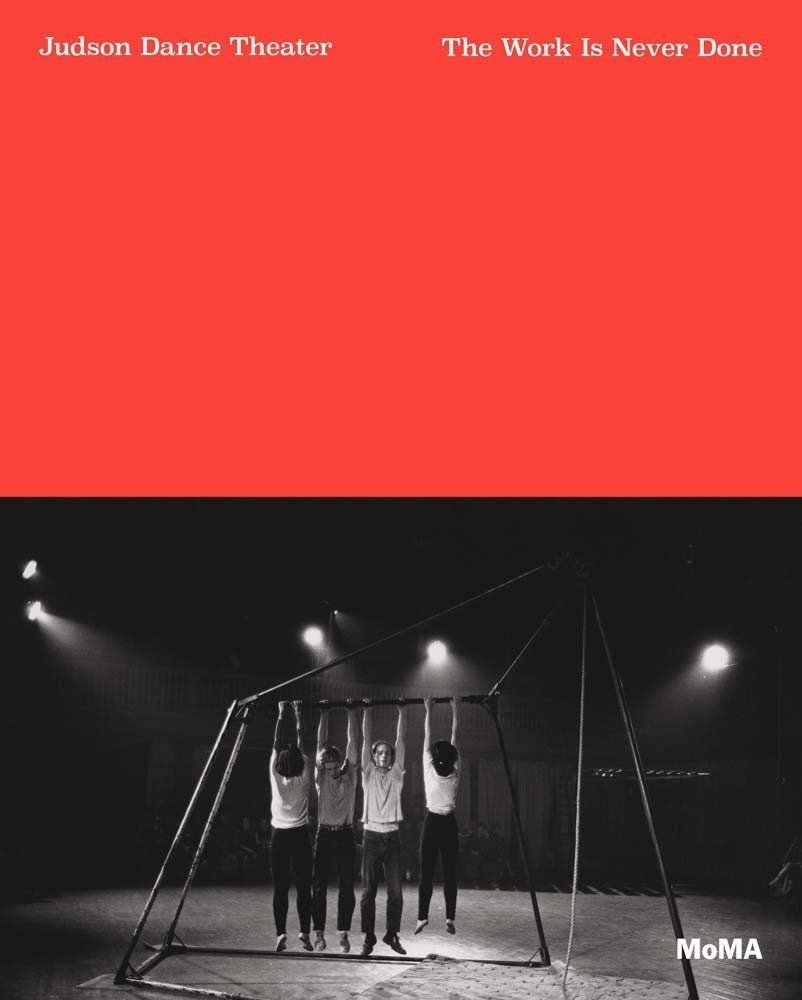
David: Again, last time we spoke, you talked about how you had obtained a grant that took you to places far afield from New York.
Rudy: I was part of the National Endowment [of the Arts] touring program. And that enabled me to get out of New York. At that time, when I was in New York, I only received one grant, from the New York State Council on the Arts for $2500. And when I left New York the NEA rolled out their red carpet and I’ve gotten at least fifteen grants from them, plus the touring program.
David: And did the touring take you to Denver?
Rudy: It took me all over. [laughs] I might not have travelled Europe but I have travelled the United States. That’s how I got to Denver and Boulder. Oh my gosh. And every time I went somewhere I thought, Oh gee wiz, this is where I’d like to move. [both laugh] But that changed soon enough when I realized, Well, maybe not. For whatever reason. But I spent so much time in Denver and Boulder, it’s just unbelievable. I was there in ’76—in the mid ’70s just when the Naropa group was starting. I remember it was the year that Jaws came out [laughs] the movie [1975]. So there’s a lot of stuff there. And I was also there for a semester or quarter at the university.
David: In Boulder?
Rudy: Yeah.
David: Because I was at Naropa a couple of years [later]. I had an apprenticeship with Allen Ginsberg, one of his many, many, many apprentices.
Rudy: What year was that?
David: I think it was ’78.
Rudy: Oh, wow. I had already left. I was out here.
David: I’m going to go a little bit further back in time. Because of what’s going on right now with people in the streets, the talking heads inevitably are comparing 2020 with 1968. And I’m wondering if you had any memories. Was there anything that struck you about that year? Martin Luther King was assassinated, Robert Kennedy, the Democratic National Convention in Chicago, the shootout with the Oakland Police and the Black Panthers, and what some people felt was the stealing of the Democratic presidential candidacy [for] Humphrey, which mirrors in some ways the way people are feeling about Bernie Sanders and Joe Biden. All you have to do is go to Wikipedia and select 1968. I’m just wondering if what was in the air had an effect on what you were doing.
Rudy: In that sense, because of the riots or anything, I was aware of them but I was always out on the road or somewhere in residence, and that kept me pretty occupied. I think the only time, like when [John] Kennedy died, I was living in New York and I was much younger. I was working a 9-to-5 job and I just couldn’t get to work, I was just so moved by the whole thing. And I was also there when Castro came to this country,1 living on 32nd Street in a cold-water flat with the john out in the hall and no heat. [both laugh] And that apartment was passed down to me by Grover Dale, dancer, actor. You’ve heard of Grover Dale, right? Did a lot of Broadway also.
David: I don’t know that name.
Rudy: He’s still around. He came here way before me. In the ’50s, he split from Gene Nettles, who went off to Europe, and they gave up the apartment and I took it over. Only $43 a month. But with the tub in the kitchen, the john in the hall, no refrigerator.
David: I was interested in the fact that in your program for the first performance of Remain in Light or Take Back Your Yellow Ribbon, you dedicated it “to the Men and Women in the Persian Gulf.” Of course you didn’t say, “Service Men and Women”; you said “Men and Women”—
Rudy: Right.
David: —which I think was pretty universal. So the dedication was different than the impetus for the piece. Before the performance you’re quoted in the L.A. Times saying:
Because of the war and recession, my company’s morale is down. For a long time I didn’t want to dance because I didn’t need to. For me, the creative process—choreography and teaching—is the most exciting part. I don’t have that thing about having to be in front of the audience. But I wanted to do this to raise our spirits and regenerate. I feel like the ship is sinking and I’ve decided to jump into the water and save it. Now that I’m into it, I have a reserve of extra energy and suddenly I feel alive again.
David: If critics extrapolated from the dedication, that the performance had something literally to do with the war, that was their interpretation and not necessarily your intent.
Quoting the dedication for Made in L.A., for which Remain in Light was the centerpiece, L.A. Times dance critic Lewis Segal wrote that the entire work “seems to explore the war’s impact on different sensibilities.” Thus his review is through that lens, beginning with the score, composed by Rob Berg and myself (“incorporates what may be distant thunder—or something far more ominous”). Segal wrote that Rudy’s solo “links a meditative, communal, ‘exotic’ opening section (the four-member Perez company dressed in saffron robes) with a dancey, convivial, ‘domestic’ finale (the cast wearing California shorts and singlets).” But neither the costumer, Susan Perry Miick, nor Rob and I ever were let in on Rudy’s grand design “to explore the war” in any fashion. Because such a scheme didn’t exist.
Rudy: Well, I don’t see my work as being literal. I mean I see it as being abstract and I really feel it works when people get different interpretations of it. What year was that, by the way?
David: That was 1991.
Rudy: That was the year I did Dance-Crazy Kid [from New Jersey Meets Hofmannsthal (1992)]. I really don’t remember a lot of it. I was just telling someone the other day, I’m fortunate to be going through your doing what you’re doing, but so much of the past is just going, going, going, gone. It’s nice to reflect and try to remember but I can’t actually state where I was mentally at that time because it was that time. Like the time I’m going through right now. So I can’t give you an honest opinion about that time.
David: I do remember. And this was my ignorance, not knowing about your career, although you did sit us down, Rob Berg, my collaborator on the score [of Remain in Light], and showed us some of your [early] work on videotape. You kept talking about how you were going to be performing again. And I hadn’t realized that that was a major step for you, since you hadn’t performed since 1983.
Rudy: Right. And so much of it was that, up to that date, we did plenty of company performances. But there was such a demand for me to do solos and I didn’t want to. And so for the longest time I just didn’t, until this particular moment. And all of a sudden the phoenix rose and I started to do this solo. But it was just because of what was happening at that time or how I felt or…
David: Well, what happened is, the first string of performances [of Remain in Light] was at LACE and the sound person got the flu. They called me and asked me to come in and do sound. [laughs]
Rudy: See, I don’t even remember that.
David: Well, I distinctly do because I was really mad. I did not want to have to do that, mainly because of my own insecurity. Because, as I remember Loop I began with our score, which was bell tones droning [alternated with fragments of Vivaldi’s two concertos for mandolins, requiring precise, synchronized audio and lighting cues]. The company, I believe, was in saffron robes by—
Rudy: Susan Perry Miick.
David: —and umbrellas.
Rudy: That was quite a piece.
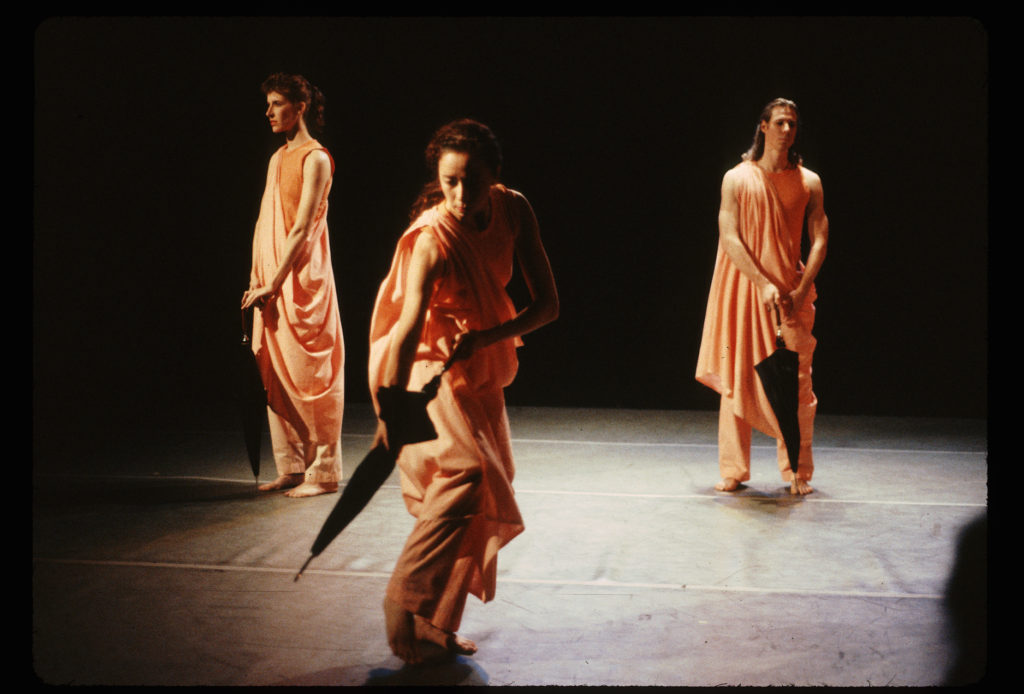
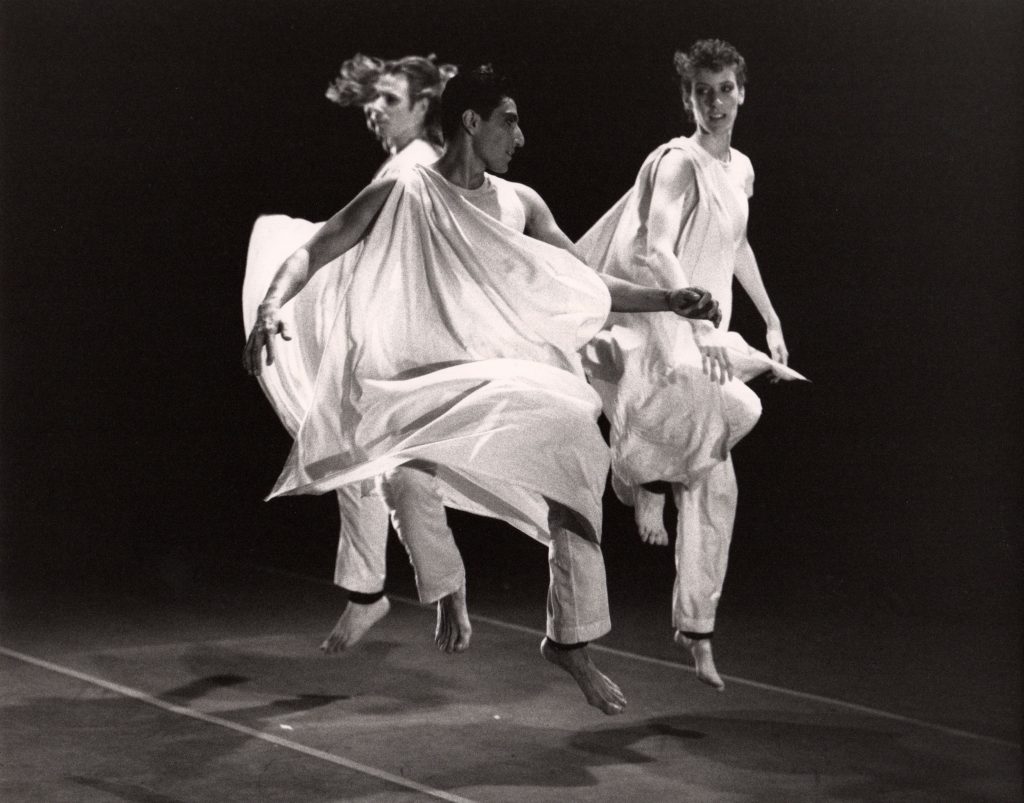
David: It’s just stunning. Your photographer Nixson Borah came to me at some point during the three nights and said, “I believe that the coming together of your scores and the ensemble’s choreography, dancing,” and of course your solo, “is the most impressive that I’ve ever seen.” Meaning that the way it worked together. And in [some] cases I know there was some opposition, because Rob told me that he had never experienced asynchronized dancing before. And so there must have been an element of that. That’s why I’m eager see the video.2 But then Rob saw Cunningham recently and he told me, “Oh, I get it.”
Rudy: [laughs]
David: But he hadn’t gotten it at the time. [chuckles] I had, because I had worked with you in the workshops.
Rudy: Right. So what was the connection with Cunningham, that he all of a sudden got it?
David: I think the part where [Merce] talks about the counting.
Rudy: Oh, right, yeah.
David: And you had mentioned the counting in your newsletter, and so I put that into Part 1 of the interview.
Rudy: So much of the work chronology is on the website. Have you checked the website?
David: I have, yeah.
Rudy: There’s so much on there. At least it’s there, but it’s not as together as I think on a certain level is what you’re doing. Not that that’s been my frustration; my frustration has mainly been with the archives at USC. They don’t have the archives in any sense of order that anyone could get anything out of it. I hope you’ll get a copy of that.
David: The finding aid is absolutely thorough. And there are two ways it can be accessed. One is an interactive (and I would say less useful) finding aid, meaning you have to kinda know what you want to be able to get what you want. But there’s another method, which is OAC, Online Archive of California, which I use in my own work and which displays the finding aid as one long text document. It can be easily browsed and searched; it’s much easier to use. And it’s all catalogued. There’s nothing hidden.3
Rudy: I wonder if they can find the time that I was a guest at Rona Barrett’s Show [July 24, 1981, in the finding aid].
David: I remember watching that live.
Rudy: And I did it on top of her desk: Equinox-Run. That was quite something.
David: I remember you were just tickled to death to be there. She asked you how you were or something like that and you said, “Well, I’m just pleased to be here.” [laughs] It was so great.
Rudy: That was a time. It’s always nice when people, especially people outside of your profession, acknowledge you and they want to share your work with the public. Especially Rona Barrett and then of course there was The Today Show with Barbara Walters in New York [not in the finding aid].4 There was always that, and that was always very exciting. And people always bent backwards. The Today Show—I wish we could find a copy of that—they really bent backwards. It was unbelievable. And a lot has to do with a sense of respect I have for myself and my work. And people not understanding the nature of my work or where I’m coming from [chuckles] or the work. So that’s always been frustrating.
David: I wanted to talk with you about the second performance of Remain in Light at the Japan America Theatre. I’m pretty sure you saw Kazuo Ohno when he performed at the Japan America Theatre.
Rudy: Who’s he?
David: The butoh master who did his homage to La Argentina, the Spanish dancer.
Rudy: Yeah, yeah, yeah. If I recall, maybe I did.
David: It just seemed to me that whatever alterations you had made to that solo became a homage to him. I’m just wondering if there was any connection there between reinterpreting the solo and Kazuo Ohno’s performance.
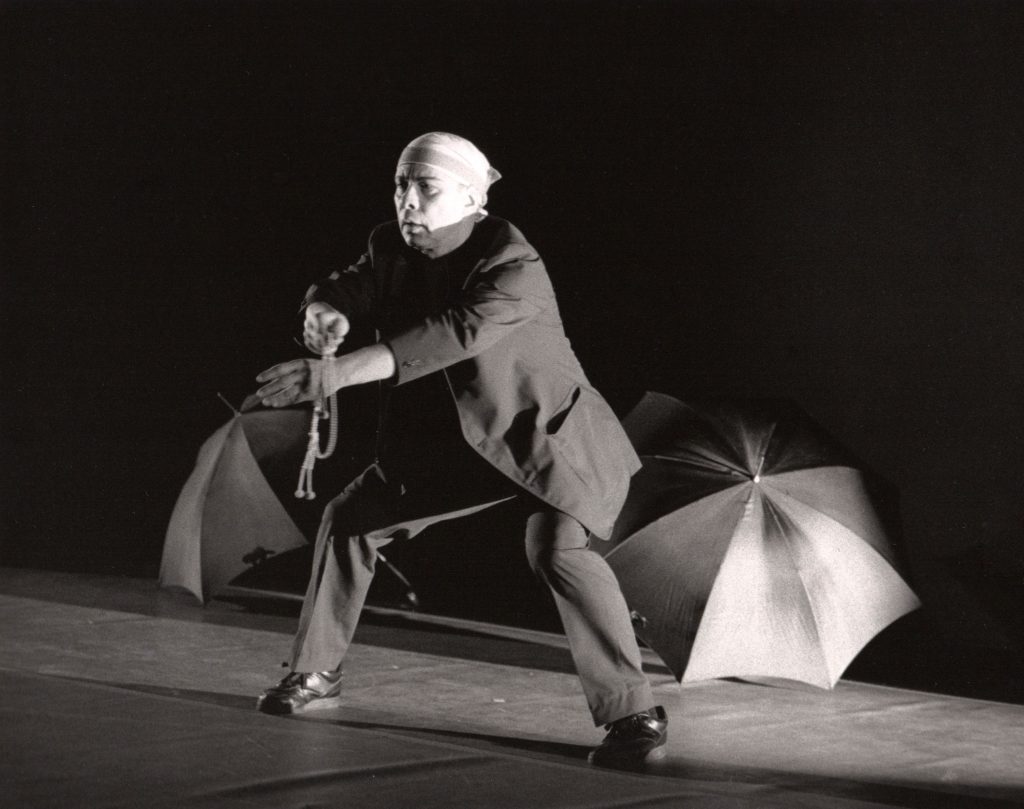
Rudy: Certainly at any time when I see someone whose work is of that nature and really stirs me and makes me think about the possibility of doing something differently—it’s not so much that I, like so many people do today, they don’t have the discipline or the way to find their own way of doing it. My intent was not to copy him, but try to find a way to find the inspiration from the work so that I could apply it to my own work. Because the work has a lot of integrity. During the 1984 Olympic Arts Festival I did a homage to the Sankai Juku company, a piece called Where Angels Coast because [Sankai Juku] did this piece at the Dorothy Chandler Pavilion—
[the following video is grayed out until fully loaded]
David: Oh, that’s right. I was there.
Rudy: Not at that performance, but when they were up in Seattle, one of the dancers fell, and I was so moved by that performance and all of that, that I decided to create this piece Where Angels Coast. And I did that in New York. Oh, wow. [laughs] Oh… So much, so much.
David: So many memories. And so many memories that include you and that whole time. I feel like in some ways I don’t know anything about you [chuckles] and then it turns out I know quite a bit because I did study with you.
Rudy: I think we all had our own issues and things were much more accessible. We were able to do what we did. We did the best we could. It’s not so much that we took things for granted, but this was the way it was. I mean, it was possible to do whatever you could as long as you had the opportunity to do it, but you had to work at being good at what you did. And of course you were influenced and inspired by other great artists. I don’t know how Robert Wilson came up artistically, because in many ways he’s been a big influence also. But we’re contemporaries; he’s only ten years younger than I am. His work was monumental. Unbelievable. How do other artists get to a place where they find other people’s wonderful works so inspiring that they come up doing magnificent work themselves?
David: Well, I recently listened to Bachelors Anonymous, the group that I had with Rob Berg.
Rudy: Oh, I remember that.
David: And then you asked us to do the score for [Made in L.A.]. And so I haven’t listened to our music in probably fifteen years. A historian had digitized pretty much all of our work and when I was looking for stuff on you I came across it and listened to it last week. And I hear the influences. [chuckles] Other people may not, but I know what I lifted from others—mainly lyricists. Musically I hear some similarities, but I was the lyricist for the most part for Bacheolors Anonymous and so I know [chuckles] what I lifted. And, y’know, you just kinda take it in a different direction and it becomes your own. It’s almost like doing a cover of a standard. Are you going to be faithful? Or are you going to make it your own?
Rudy: And because of the opportunities I’ve had I could never just think of doing a piece for a small venue. But my head had to be at a place where I was doing a piece for a large venue. [laughs] So my thinking and my work at Judson, what I was going to do really had to be at a place where it had its own sense of where Rudy Perez was, coming from where he is at the time. Yes, there might have been influences, but I can’t say people have often said that work’s been influenced by other people, other than me saying it. They might compare the work professionally, on the craft, or the work to [that of] other artists, but I don’t think people can say that I ripped people off.
David: I don’t think so.
[both laugh]
Rudy: I could say they might have ripped me off.
[both laugh]
Rudy: But it’s not so much the people who are professional; it’s just a lot of younger people who think that they’re very original.
David: When I first [talked] with you after we reconnected, you remembered the Mattachine Society in New York, I think. Did you have any contact with those people?
Rudy: No. I think I had more contact with them when I came out here because Joseph—
David: —Shuldiner—
Rudy: —and his buddies, they got involved with me because of my work and they invited me to some of the meetings. And I met them—the head of the Mattachine—and they knew who I was, and that’s as far as it went.
David: Harry Hay, who’s considered the father of the modern gay civil rights movement was a friend of Sara Shuldiner and maybe even a friend of her sister—[chuckles] whose name is escaping me! Famous choreographer.
Rudy: Oh, Bella Lewitsky. Wasn’t Joseph related to her as well?
David: She’s Sara’s sister, so Bella was Joseph’s aunt.
Rudy: [chuckles] It all comes back.
David: Because you received the Lester Horton award for Remain in Light at LACE. And I told you, which you hadn’t known, that Harry Hay met Rudy Gernreich and then they formed the Mattachine, but they met at Lester Horton’s studio because Harry’s daughter was studying with Lester, and Rudy Gernreich was a dancer and also doing costuming for Lester.
Rudy: I’m only sorry that I was never at a place—I know that when I was in New York he did visit sometime in the ’50s—but I never had the opportunity to really meet him. I often questioned other people who know him, “Would we have gotten along?” [laughs] I feel kind of left out, or missed the boat there, not having the opportunity to have been associated with him in some way. Because there are so many people that I have been associated with. Not the West Coast, you know.
David: And what was the response? Would you have gotten along with him?
Rudy: Yes. They would say, “Yes.” [laughs] They all said yes.
David: Well, Andrea and I had a favorite watering hole on Colfax in Denver before all this happened. And we went in one night and the place had been turned into a flamenco paradise.
Rudy: Wow.
David: It was amazing. We thought we’d be turned away. Somebody saw Andrea—she’s kind of frail now—and took her under her wing, brought her over to their table (I was parking the car). I had no idea this was happening: the local flamenco maestra was performing. We got to talking afterwards. The woman who rescued Andrea studied I think with this same flamenco dancer, but turns out she has been trained in the Horton Technique, went to Horton confabs. So it exists; it goes on.
Rudy: Right, right. I find the technique—in that I, and some of the other people who were teachers or people who worked with [Horton], like James Truitte—very strenuous, very fatiguing. And my conclusion when I was examining Why was it?, I felt it had a lot to do with the fact that the technique was devised with this environment, a West Coast environment, because it’s so easy not to do anything here.
David: [chuckles] So you have to kind of bring people in line?
Rudy: Well, the technique is very fatiguing. They just keep repeating things until you wear yourself out.
David: And you would contrast what you do…
Rudy: That was just a curiosity.
David: But would you like to contrast that with…?
Rudy: No. That was just at the time. Because I was very aware that the Lester Horton Technique was a big technique everywhere. More so out here than I think in New York. But I was only disappointed that I didn’t meet the man; I wanted to. I mean, the same thing with Jack Cole; I never did meet him. I admire him for what he’s done, but I also know that he was very demanding. It’s just a whole other place.
David: I don’t have any more questions, but is there anything that you want to leave us with?
Rudy: Well, we’ve covered a lot. And like I mentioned earlier, the day has been very difficult for me, dealing with the protests and finally realizing that it’s not over and that it’s still something I’m trying not to allow to get to me. Not that I don’t care, but as we well know it’s not over yet. We don’t know how far it’s going to go and what’s going to happen next. And still worrying about the virus and trying to keep myself at a place where I don’t come down with something. Myself at 90 and a half [laughs] worrying about my own health. And how much capability am I going to have to even go to the john on my own and take care of myself. My vision is pretty bad but I stay in my apartment and I’m quite familiar with it. It’s small and the walls are close and so I can hold on to them if I fall—I have fallen. So that’s a big fear. That’s one of the things that does happen to people that are older, is falling; you go off balance. How I manage…. But I do exercises to kinda keep my leg strength. I’m very fortunate to have a support group around me, former Ensemble members and others.
David: Good. You talked about circadian rhythm. You’re partially sighted, correct?
Rudy: Yeah. Visually impaired.
David: So if you’re able to recognize day from night—you told me that you keep a circadian rhythm. You don’t let yourself go off of that.
Rudy: I mean, I don’t have the choice. I can’t go out and run around. I think maybe when I had the opportunity and when I was driving, maybe I was not so much on that [rhythm]. But being sheltered down here, not so much because of just the virus but because of being an older person, I do try to get to bed at an early hour and I try to get up at a reasonable hour so I don’t spend any more time in bed than I have to. And find some way to keep myself active, my mind and my body.
David: Thanks for this.
Rudy: Again, it’s just the tip of the iceberg, you know.
David: That’s all we can do. But then, who knows?
Rudy: It’s not that I’m putting you down for it or reprimanding you for it; it’s just that there’s so much. I mean, my time in Boulder alone [chuckles] is unbelievable. Or any place that I spent any length of time in the United States. As long as I can hold up and see each day through the light, feel good about myself. That’s the most important thing. And my mind is clear, you know, I’m so fortunate that my mind is clear right now. I realize I’m beginning to forget things. I might be going into the kitchen—my apartment’s very small—and midway I forget why I’m going into the kitchen. And I have to stop and, Oh yeah, [laughs] recall. But usually someone my age is in assisted living or in a nursing home. Because I’ve seen so many people in this building: they’re there now or they’re dead.
David: Stay well, stay safe.
Just as our conversation brought back memories for Rudy, my own were kindled. Last week I told my collaborator Rob Berg that I’d been amazed at how he crafted the music for Made in L.A.‘s Loop II: “You were like a lithographer, each musical line a pass of the press, resulting in a whole.” Rob recalled that one of Rudy’s dancers, Robert Keane, who also was a musician, became Bachelors Anonymous’s vocal coach. The choice of monks’ robes for Loop I is of interest to us because before I met him Rob was on the path to becoming a monastic in the Ramakrishna Order of the Vedanta Society of Southern California. When Rob and I dissolved Bachelors Anonymous it was because I wanted to devote myself to my own “spiritual quest,” the subtitle of Loop I. Digitizing the score for Made in L.A. has spurred us to begin to fulfill a languishing musical quest: to post all of the our collaborations for Bachelors Anonymous and beyond. And beyond, Rob has gone, working in film; his filmography is available at IMDB.com.
Dusting off manila folders in the process of preparing Rudy’s interviews I came across our first performance, which Rudy and I did with my loftmates Joseph Shuldiner and David Moreno. It was forty years ago this summer. I have the tapes, the notes, the publicity and program, and a Drama-Logue review. That will be the next installment.
Part 3: Anatomy of a Performance
Header image:
Circadian Circle,
Rudy Perez Dance Ensemble,
photographed by Mark Hanauer,
courtesy Susan Perry Miick
Notes
- Fidel Castro came to New York City in Sep 1960 to attend the United Nations General Assembly. Among the guests at a Fair Play for Cuba Committee reception for Castro in Harlem was Allen Ginsberg, who would have a love-hate relationship with the country, eventually being expelled from the country in 1965. See Barry Miles, Ginsberg: A Biography (New York: Simon and Schuster, 1965, 275, 351–352, 367–368).
- I have requested access to video of Made in L.A. from the Rudy Perez Archive at USC.
- In the course of preparing this post I found out from Susan Perry Miick that she helped Rudy organize his papers for the USC accession in 2002. I also learned that my collaborator Rob Berg did the same in 2015 for Lewis MacAdams, the recently departed poet known for championing the Los Angeles River amongst other things. And I did the same in 2018 for the late David Anderson, an ex-prisoner who helped shut down Colorado’s “Old Max” prison in 1979.
- Barbara Walters left The Today Show on 04 Jun 1976, just before Rudy’s District 1 reprised on television as part of the Dance for Camera series the week of 13 Jun 1976.


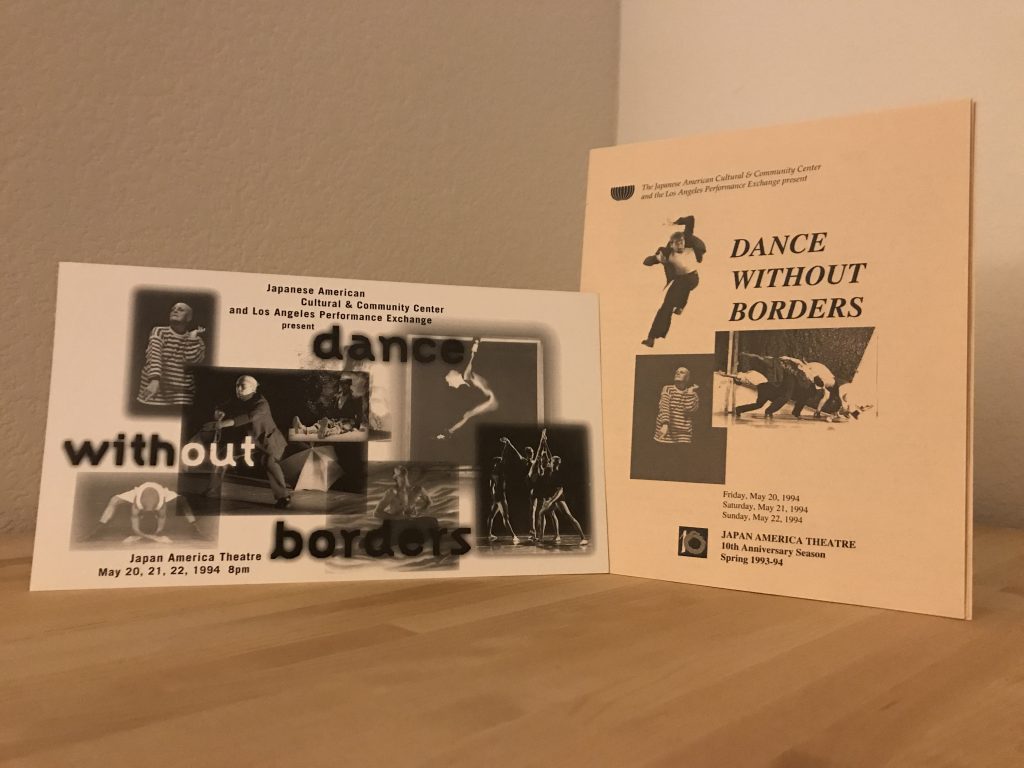
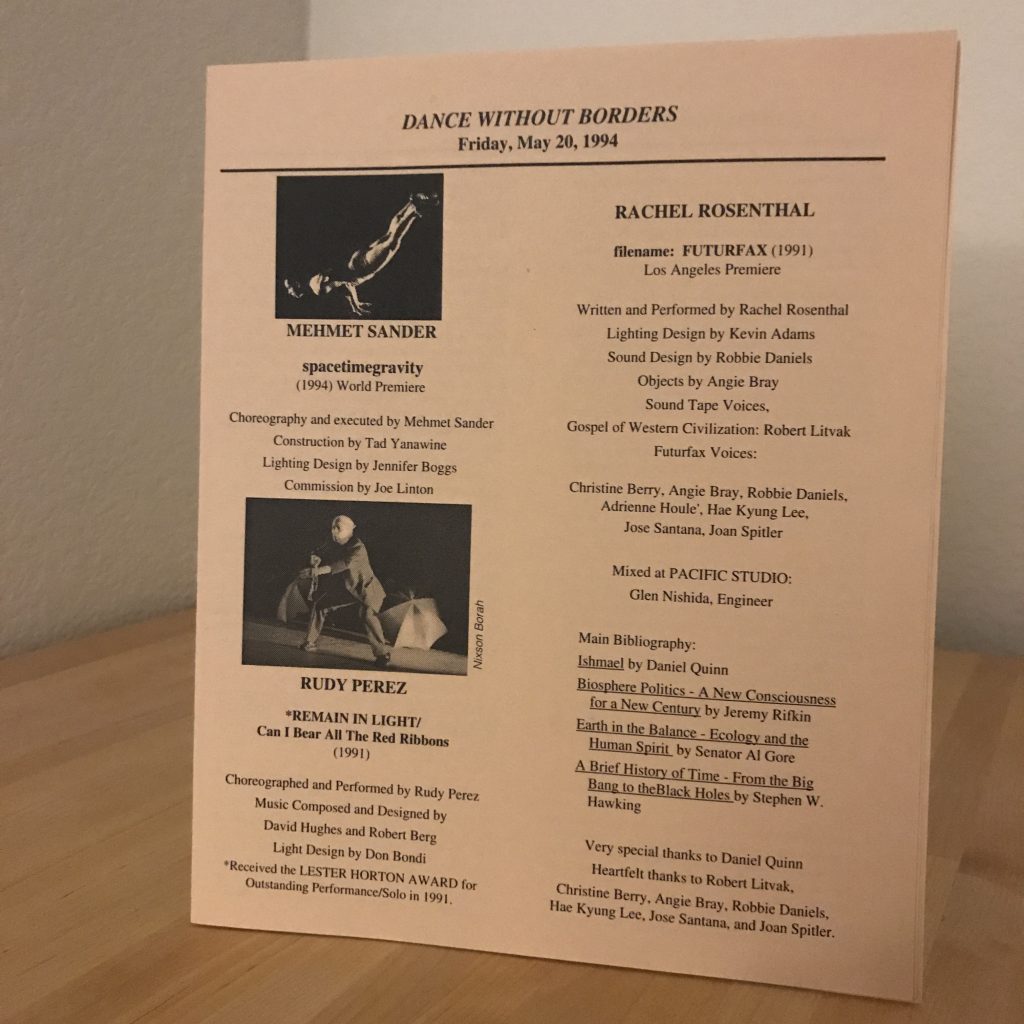
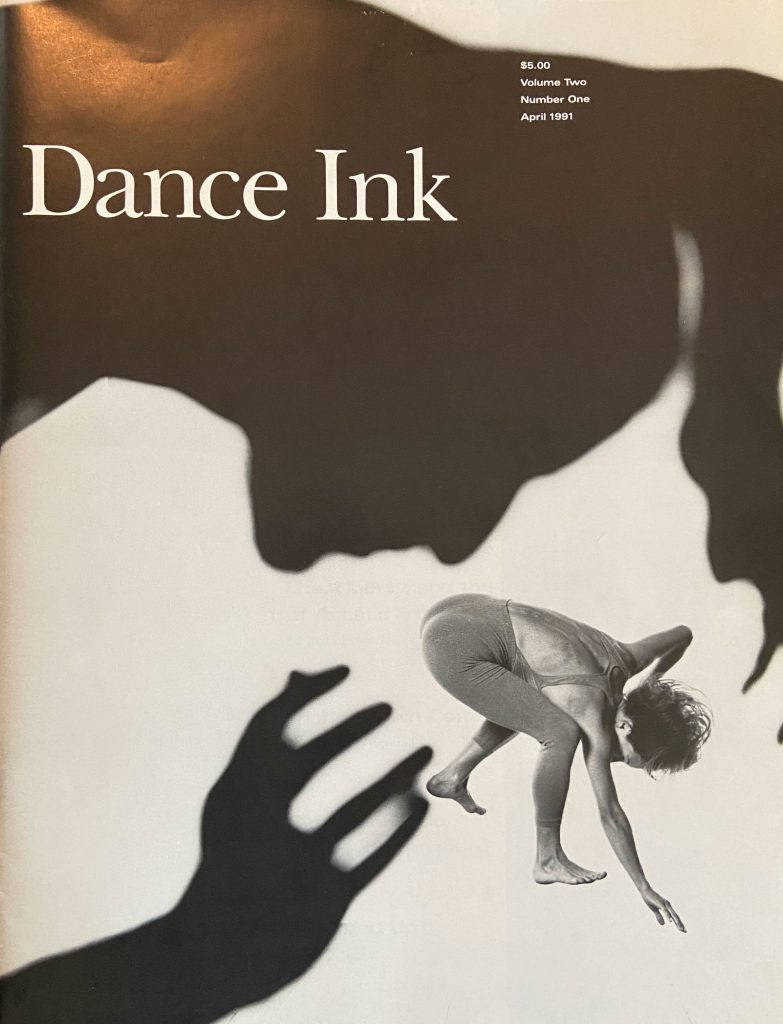
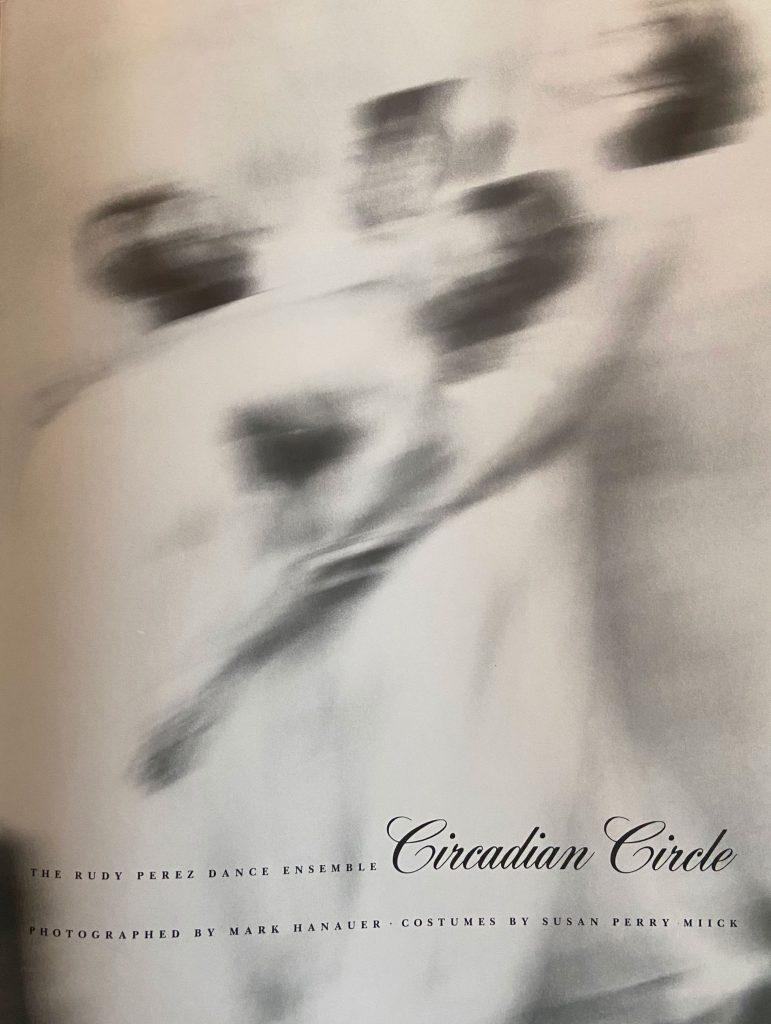
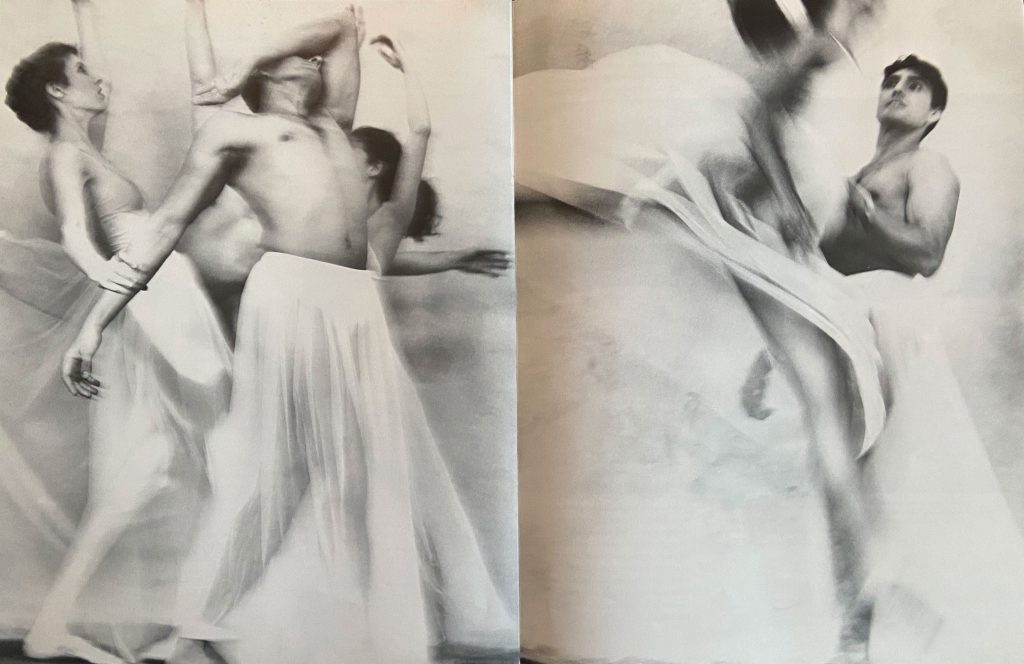
One Reply to “Portrait of Rudy Perez 2: Remain in Light”